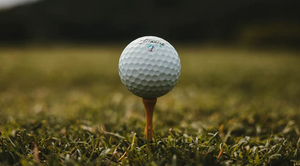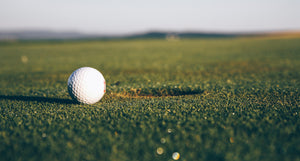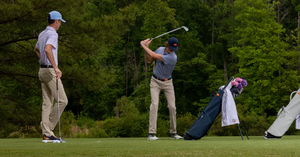How to Grip a Golf Club for Beginners: A Step-by-Step Guide
PGA hall of fame golf legend Sam Snead once said, “If a lot of people gripped a knife and fork the way they do a golf club, they’d starve to death.”
It's a statement that might seem like hyperbole to the inexperienced golfer. But any veteran of the green will tell you: grip is everything.
You can spend all your free time worrying about the weather, the layout of the course, your swing, and whether you have the proper clubs. But if you don't perfect the way you grip a golf club, your game will stay mediocre.
Here is the complete guide to finding the perfect way to grip a golf club.
1. Understand Your Grip Size
No two clubs are alike in their design. Understanding the grip size of those clubs is crucial. It allows you to learn the best way to grip a golf club.
Every club has a rubberized portion at the top. That's where your hands go. There's an entire standardized system for these sizes, ranging from 1, the smallest size, to +8, which is the thickest.
The standard size is 1, coming in at 1/64" and providing the least amount of material between your thumb and fingers. That ranges up by double sizes, all the way to +8, which is 1/8", also called over-sized or jumbo.
When you get to stage six in this guide, and the troubleshooting reveals that you're often slicing or pulling, it may not be the way you hold your clubs. It may be the grip itself. Keep that in mind as you work on your swing. A proper fitting from a PGA professional should be able to help with this.
2. Position the Club in Front of You
Start by taking the club in your hands. Don't think about technique right now. Simply take it up and hold it as comfortably as possible.
Notice your standard way of holding, and take that as a building block to apply the technique. Position the club is waist-high, directly in front of you, and square it facing the ball.
You want to feel comfortable in your golf grip. As you modify the way you hold the thumb and fingers on each of your hands, naturalize those changes.
You want to build muscle memory so that they recur automatically when you pick up your club again. More than an instinctive hold, your muscle memory of how you grip a golf club is a skill. It will take a few attempts to develop.
Your square one should always feel the most natural, so if it takes some adjustments until it feels right, that's okay.
3. Find the Best Grip for You
Now we develop the way you naturally hold a golf club into the swinging style that you'll use for every round.
Always hold the club first with your left hand. We'll discuss what to do if you're left-handed later on, but for now, simply reverse the instructions as you read along, i.e., left hand for right-handed people, right hand for left-handed. Cradle the club with your left fingers and curl them around the club.
Apply your right hand onto your left thumb and close your thumb and forefinger around the shaft. This golf grip creates the “V” that golfers always talk about when discussing grip. The “V” should point to your sternum and is the central fulcrum of power by which you'll drive your shot.
This kind of grip is the most common, but there is a huge variety of ways to hold a golf club.
Ten Finger Grip
Not every golfer holds the club in a way where all their fingers touch. The ten-finger position involves one hand stacked on top of the other hand, with pinky touching the thumb.
The following two techniques use only eight, seven, or even sometimes six fingers to achieve their golf grip.
Interlocking Grip
The interlocking style begins by forming a ten-finger hold but modifies by interlocking the pinkie finger with the other hand's index finger. Many golfers feel that having their hands connected adds power to their swing.
Overlapping Grip
The overlapping style is the most controlled style, in which the pinky rests on the ridge between the index and middle finger of the other hand.
Play around with these golf grip styles to find the one most comfortable for you.
4. Assess Pressure
Assess how much force you're applying to your golf grip by using your hands and your eyes. You should be able to feel whether you're choking the club too much or whether it's too wobbly between your fingers.
If you can't tell whether you're holding the club correctly, you should be able to look down and see if you have the correct grip pressure or not. If you're white-knuckling, you know you're gripping too tight. If the club is knocking between the palms of each hand, you won’t have any power in your swing. The grip is too loose.
Assess the pressure you're exerting, and then do some practice swings.
5. Check Your Trail Hand
A trail hand in golf is the hand that you place on the lower side of the club. If you're right-handed, that'll be your right hand, and if you're left-handed, it'll be your left hand.
Your dominant hand should drive the course and power of your swing, so you want it beneath the club.
6. Troubleshoot
Now that you've gotten the perfect golf grip, test it. Check the “V,” make sure you position your trail hand correctly, and swing.
Practice in this game does make perfect. Never get too attached to what you think you should be doing or methods of gripping that “feel” right. You always need to make way for what is good and not settle for what is merely easy.
FAQs
Is the Grip the Same for Left and Right-Handers?
As mentioned earlier, the instructions for proper golf grip reverse for left and right-handers. Thankfully, all the good golf grip tips remain as crucial for lefties as they do for righties. They just require some adjustment.
On a left-handed golfer, the right hand is the weaker hand and goes atop the club. The left hand is the power hand and the steering hand. It goes over the weaker hand and forms the golf grip, guiding the ball toward its destination.
Do You Hold Drivers and Irons the Same Way?
The function of a driver is quite different from the function of an iron. The same goes for putters, hybrids, and wedges. But the grip is generally the same for all of them.
The instructions in this guide pertain to drivers. When handling an iron, remember that irons are shorter than drivers. Because of this, you don't need as much rotation on your swing, and you'll need more control.
Irons are for shots you want to strike solidly. They are for distance control. The actual grip, however, won't change much between the two.
The only club in your golf bag that will require a different grip is your putter.
What Is the Proper Grip Pressure on a Golf Club?
Pressure is going to differ between types of clubs. You're going to apply more pressure to a driver to achieve maximum distance on your ball. But a putter is softer, and the ball travels a shorter range.
The proper amount of pressure depends on what you're swinging with, how far you want the ball to go, and the style of golf grip you use.
How Do You Hold Your Hands on a Golf Club?
No one of the grip techniques listed above is better than the others. They're just different and work better for the different hands of different types of golfers.
You'll always want your strong hand guiding the shot and some amount of control between your thumb and forefinger. But beyond that, it's all personal comfort and customization.
Perfect the Basics
Perfecting the basics is the quickest route to a great game. Don't get tripped up by advanced techniques. Focusing on the fundamental elements of what makes a good stroke will take you further than any fancy training can do.
Check out Stitch Golf's online shop for the best selection of high-quality golf gear and accessories. Don't settle for second-rate gear, and don't settle for a second-rate game. Perfect your golf grip for the most enjoyable games.


